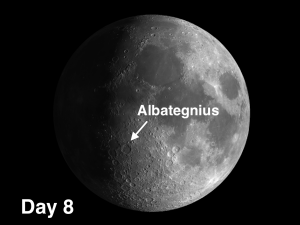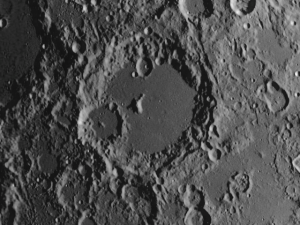 The week of May 21-27 takes us from Day 7 to 13. This week we will highlight the crater Albategnius viewable on Tuesday evening. (Info repeated from the 12/25/17 blog as there would have been a diminished audience on Christmas Eve.)
The week of May 21-27 takes us from Day 7 to 13. This week we will highlight the crater Albategnius viewable on Tuesday evening. (Info repeated from the 12/25/17 blog as there would have been a diminished audience on Christmas Eve.)
 Albategnius: [SE/L10] Albategnius is a delight! It is an 85-mile complex crater located just east of the Ptolemaeus trio (also visible tonight) in the central Highlands. Sunrise over Albategnius is a lovely sight, as the jagged peaks on the eastern rim will cast many shadow spires on the floor. This is a good place to observe the standard sequence of crater formation. Look for hints that alert you to the comparative ages of the different craters.1 On its southwest rim, Albategnius is overlapped by Klein (27 mi.) which in turn is intruded upon by Klein A (± 5 mi.) on its NE rim. Both Albategnius and Klein have central peaks, but notice how Albat’s central mountain seems to have been pushed off center and, astonishingly, a meteorite has landed with precise accuracy on the very tip of its highest peak, leaving a tiny craterlet as a memento! Because the craterlet is only 1 mile in diameter, it will seriously test your optics, the seeing conditions, and your experience!
Albategnius: [SE/L10] Albategnius is a delight! It is an 85-mile complex crater located just east of the Ptolemaeus trio (also visible tonight) in the central Highlands. Sunrise over Albategnius is a lovely sight, as the jagged peaks on the eastern rim will cast many shadow spires on the floor. This is a good place to observe the standard sequence of crater formation. Look for hints that alert you to the comparative ages of the different craters.1 On its southwest rim, Albategnius is overlapped by Klein (27 mi.) which in turn is intruded upon by Klein A (± 5 mi.) on its NE rim. Both Albategnius and Klein have central peaks, but notice how Albat’s central mountain seems to have been pushed off center and, astonishingly, a meteorite has landed with precise accuracy on the very tip of its highest peak, leaving a tiny craterlet as a memento! Because the craterlet is only 1 mile in diameter, it will seriously test your optics, the seeing conditions, and your experience!
Immediately east of Albategnius, touching its rim, you can see further evidence of Imbrium sculpting, verifying that Albategnius was in place before the impact that excavated Mare Imbrium.
OF ADDITIONAL INTEREST IN SPACE THE WEEK OF MAY 21-27:
For a few months to come, Jupiter will be within 2-3° of the binocular double star Alpha Librae (Zubenelgenubi), mags. 2.8 and 5.1. In spite of being a wide 231 arcseconds apart, they are a genuine, gravitationally bound pair. On Sunday evening, the Moon will be 5 ½° from Jupiter which, in turn, is only 1° 8′ from Zubenelgenubi.
1 Younger craters are almost always smaller (with a few exceptions) and craters that are overlapped by others are always older (no exceptions).
======================
It is highly recommended that you get a copy of Sky and Telescope’s Field Map of the Moon, the very finest Moon map available for use at the telescope. It is available for $10.95 at www.skyandtelescope.com and on Amazon. All features mentioned in this blog will be keyed to the grid on the Field Map and will look like this: Plato: [NW/D9]
Credits:
Courtesy of Gray Photography of Corpus Christi, Texas
Lunar photos: NASA / USGS / BMDO / LROC / ASU / DLR / LOLA / Moon Globe. Used by permission
- Rupes Cauchy: A Best Known Fault on the Moon - July 22, 2024
- Moon Crater Schickard – Crater Floor has Stripes - July 15, 2024
- Moon Craters Langrenus and Vandelinus - July 8, 2024